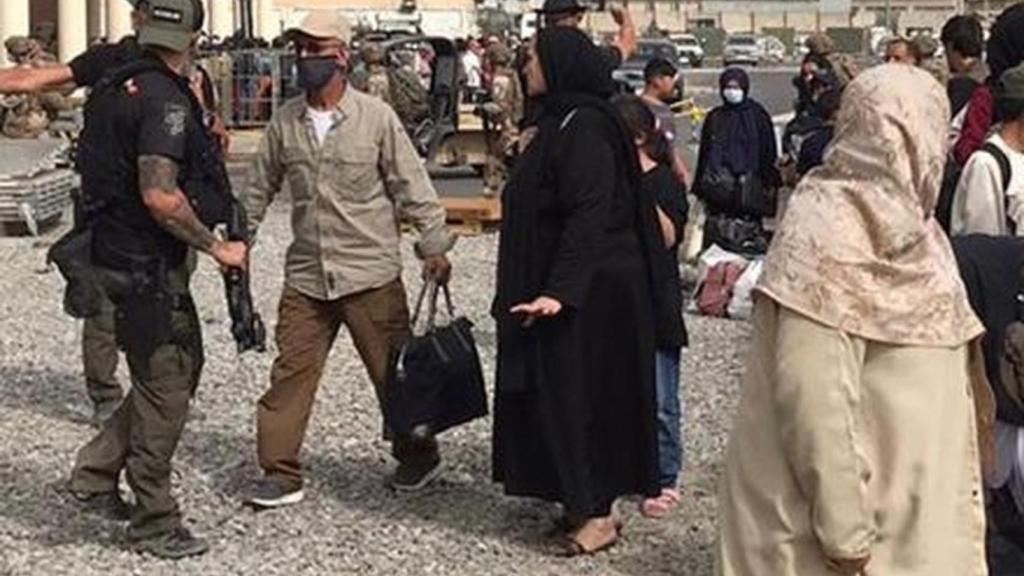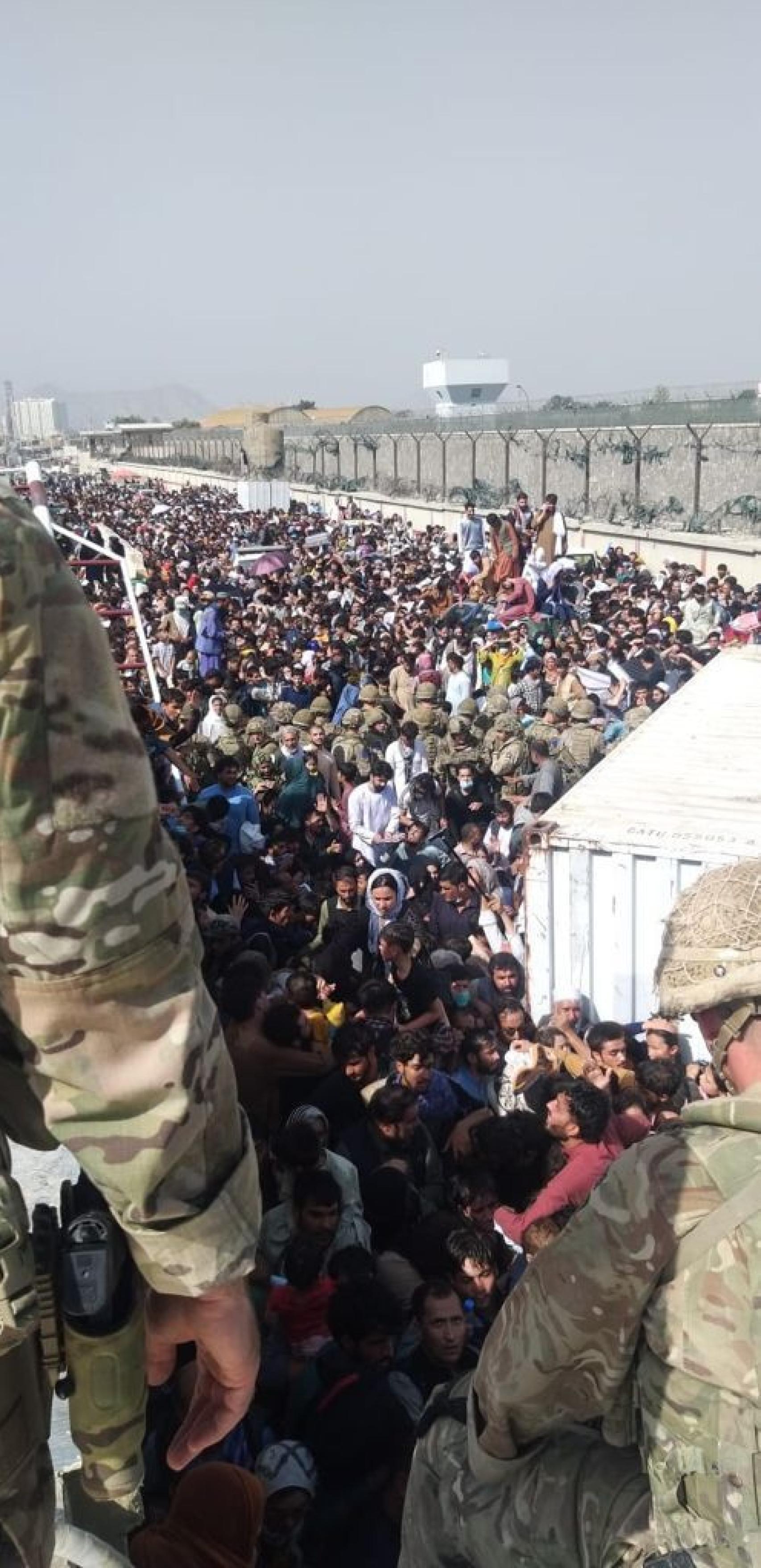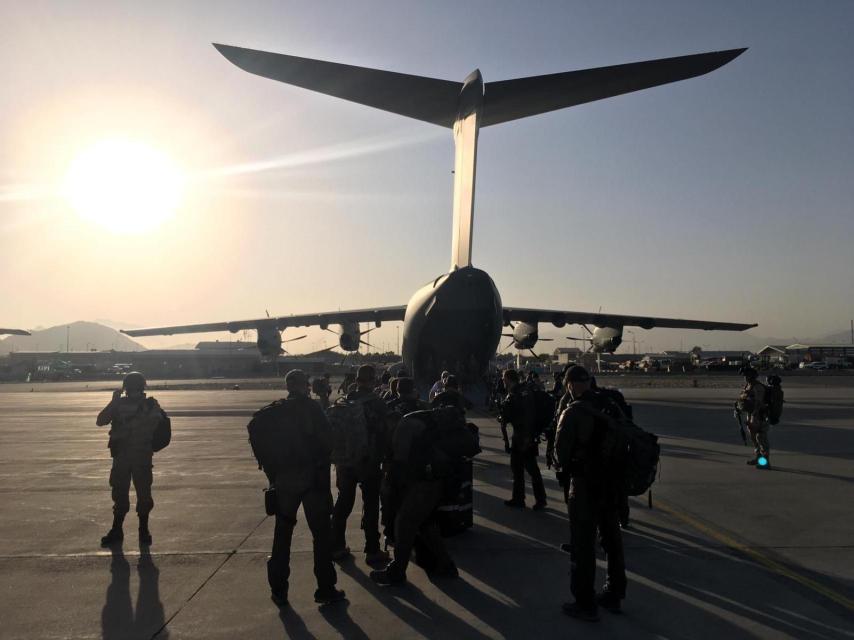Related news
Medical assistance was mainly focused on the youngest children who managed to get past the Kabul airport checkpoints. They reached the limit of their strength at the feet of the rescue planes. The policemen who were pulling them out of the human tide of the military airfield and gave them to their companions, the soldiers, dehydrated young people, with infections, burns caused by the sun.
“Even,” points Javi, one of the agents, “to a woman who had given birth at the door of the base. He had been at the door for four days. “When the child arrived, the umbilical cord was still dangling.
For nearly two weeks, the interior of the Afghanistan airport was so crowded with people trying desperately to flee their country that there were days when they had to lock the 15-centimeter-thick glazed doors from the outside, with armored vehicles, so the pressure wouldn’t blow them up.
-We are talking about a military compound -said Jaime, one of the GEOs who participated in the evacuation- And even so they had to put a truck because the mass of people pushed so hard that it could even make everything explode.
“We have seen scenes that take away our sleep,” adds Juan, another of the agents who starred in the last Spanish service in Afghanistan. Their heroism will earn them a Police Merit Medal with a red badge.
Now, two weeks after they got on the last plane after rescuing more than 2,000 people, EL ESPAÑOL has had the opportunity to interview five of those 20 agents, already known as “the heroes of Kabul”: 4 agents from the Special Operations Group (GEO) and 1 from the Police Intervention Units (IPU).
They were the first to arrive but also the last to leave. They did not want to leave until the last moment. Some days they managed to evacuate 70 people. Other days around 300. The figure for them is the least. They still know little. “We got a bittersweet feeling.”
-I remember a little boy, as it happened to me – Jaime recalls again – who was dressed in Messi’s shirt, who had been out there for five days, and when we managed to take him from the airport to the plane he hugged me as if I were his dad. That bfff …. “
They slept little, but they slept. One of its maxims is that if one does not sleep at all, it cannot be operative for its mission. So, even if it was only a few hours, all of them, in turn, lay on a pallet in the Spanish section guarded by the IPU to fall asleep for a while. And then back to the airport.
1. “On the 15th something was wrong”
The five receive this newspaper at the headquarters that GEO, the elite unit of the National Police, owns in Guadalajara. All of them report that they had previously been stationed in Afghanistan. That they knew the instability of the country. Who arrived, this time to take over from their colleagues in the region in two shifts. The first disembarked on August 5. The seconds on the 7th.
A week later, on the 15th, when Afghanistan had already been practically subdued by the Taliban, they realized that something was wrong in the city.
“The Afghan is from a proud culture, he will never tell you that he is afraid, that they are leaving for the Taliban. But something was not right,” explains Juan. “When we perceived that, we took a counter-surveillance into the street, six men and two armored vehicles. And we began to see things that make us suspicious: part of the checkpoints soldiers, who normally guard between 6 and 10 soldiers, kept either one or none. “
Spanish Geos agents in the center of Kabul, days before the evacuation began.
There his concern grew. They followed the route in the direction of the headquarters of the NDS (the main Afghan intelligence agency). As soon as they looked out they realized that there was no one there. The building was empty.
-What did you do at that time?
-When the intelligence has disappeared, all the alarms jumped Juan insists. We realized that something serious was happening, and we contacted the headquarters in Guadalajara. There began the management with the ministries.
Hours later, the United States announces its decision to emergency evacuate its embassy in Kabul.
The GEOs then alert the ambassador and plan the emergency evacuation. Upon their return to the embassy they begin to delete documents, sensitive material, files whose content would be both interesting and dangerous in the wrong hands, in the hands of the Taliban. In three hours the Spanish embassy, 16 years after its opening in 2005, is already empty, completely abandoned. They all leave for the airport. That same night they design the evacuation plan
2. The Kabul hornet’s nest
The following day, August 16, the workers set to work and set up their device to begin locating embassy staff and Spanish collaborators at the airport access gates. They choose the best located entrances, the ones that most people access, and the ones that are most conducive to their mission.
That day the interior of the military airfield became the epicenter of conflict, of chaos, the last hope for many who wanted to flee at any cost from the atrocious yoke that the Islamic fundamentalists were going to impose. It was transformed into a real, dangerous and deadly hornet’s nest. With people who were crushed to death by the crowd.
“All the embassies had sent the message that it was necessary to arrive”, insists Juan. This overcrowding becomes the main complication of the task that had been entrusted to them. A significant number of embassy workers are, yes, easily located by GEO agents. They recognized many of them easily, after having worked hand in hand for years, as well as workers from other international organizations to whom they also offered shelter.
Tribute to the Spanish policemen who participated in the Kabul evacuation mission pic.twitter.com/Q6uv2K3may
– THE SPANISH (@elespanolcom) September 10, 2021
The biggest problem came when the bulk of the personnel to evacuate were people that the agents did not know. “It was necessary to establish a filter”, insist the GEOs. The first thing they did was establish a color code: those who saw a flag of Spain or heard the word “Spain” had to take out a red cloth or a yellow cloth.
Instructions were given through the embassy so that the workers would know the message, but it was soon useless: many at the airport who were not Spanish or Afghan collaborators realized that if they raised a handkerchief with that color that might rescue them too. So after a few days that route had to be scrapped.
3. The sewer
Soon they simultaneously established a second rescue strategy: knowledge and experience in the area reminded them of a nearby sewer to introduce refugees and thus save the crowds inside the airport. That way they would be able to directly reach the other side. Through it they managed to evacuate about 300 people.
“This access point was necessary because the rest of the gates were so overcrowded that it could take days to advance five meters,” says Ismael. “And even if we saw that person we knew 15 meters from us, we couldn’t get to her.”
From that moment on, they began to name the people they had to save at certain coordinates. There they were made to descend discreetly through the underworld of Kabul and traveled the stretch that on the surface was impossible to cross. The joy, however, was not going to last long, because soon many of the thousands of people present in the enclosure found out about this kind of secret passage.
Kabul airport crowded with people trying to flee the country.
“It was the way to gain access bypassing thousands of people and also Taliban control,” Juan explains. the route lasted only 72 hours. Word spread very quickly, they saw movement and we had to block it again.
4. The children
The heat in Kabul, a city at 1,791 meters above sea level, was at times unbearable. Days in which 40 degrees were easily exceeded but with a much greater feeling. That was another of the factors that complicated the situation for people who spent days or weeks crammed into the airport looking for a loophole, the slightest opportunity.
“From the outside you cannot get to appreciate the amount of people there were per square meter. To advance two meters it took 15 hours”, says José. “There were people who had been in that situation for 5 or 6 days, with dehydrated children, without eating.”
-Imagine a Mascletá, some Sanfermines -he continues- a mass of any national holiday. Well, multiply it by five, added to the terror that everyone wanted to leave. That in that country they are going to be killed. There were real human branches, of people who left the country terrified, of families that left everything behind.
– People crushed against the walls – Juan intervenes – against the doors, very nervous people fighting …
-There were so many people that if someone fell to the ground there, they could no longer get up. What could happen was unpredictable. There came to be deaths in different avalanches “.
5. The attack
In the Kabul attack, perpetrated on August 26, a day before the Spaniards left the Asian country forever, 183 people died and 150 suffered injuries of varying severity. Minutes before the suicide massacre, the Spanish policemen had been precisely at the place where the attack took place. There, 13 American soldiers died.
The GEOs and the UIPs heard the explosion, and watched from inside the military zone how ambulances began to pass with the bodies of the dead and wounded. They did not know the military personally, but they had seen a lot of them in the previous days.
“I’ve spent so much time there surrounded by so many people that it could have been me,” José revives. Juan remembers the clear feeling that something could happen there, given the number of people there and the desire of the jihadists to mount a carnage, always doing as much damage as possible.
They know that instead of the Americans, it could have been them. A few minutes earlier and he would have caught them there. “We could have died in the attack. We were all aware that something could happen. But you had to take a certain risk. You could see it, but when you were getting people out of there you forgot everything that could happen to you. “
The next day, August 27, they boarded the last of the planes that took off from the airport for Spain, with a stopover in Dubai. A bittersweet thought invaded some of them.
“The most frustrating thing,” Juan finished, “was that we were trying to cover something that we couldn’t cover.”
One of the evacuation planes of the Armed Forces in Kabul.
Follow the topics that interest you
Reference-www.elespanol.com


